Employee Relations: Analyzing Alan Fox's Frames of Reference
VerifiedAdded on 2022/09/05
|15
|3735
|83
Essay
AI Summary
This essay critically examines Alan Fox's three frames of reference – unitarist, pluralist, and radical – within the context of employee relations and job regulation. The analysis delves into each frame's implications, exploring how they shape the employment relationship and influence approaches to conflict and power dynamics within organizations. The essay supports its arguments with relevant academic research, referencing key scholars and studies in the field. Furthermore, it enriches the discussion by incorporating practical examples of employee relations practices observed in contemporary organizations, demonstrating the real-world application of each frame. The comparison highlights the strengths and weaknesses of each perspective, providing a comprehensive understanding of how these frames influence workplace dynamics, conflict resolution, and the overall management of human resources. The essay fulfills the requirements of a National College of Ireland MA in Human Resource Management assignment.
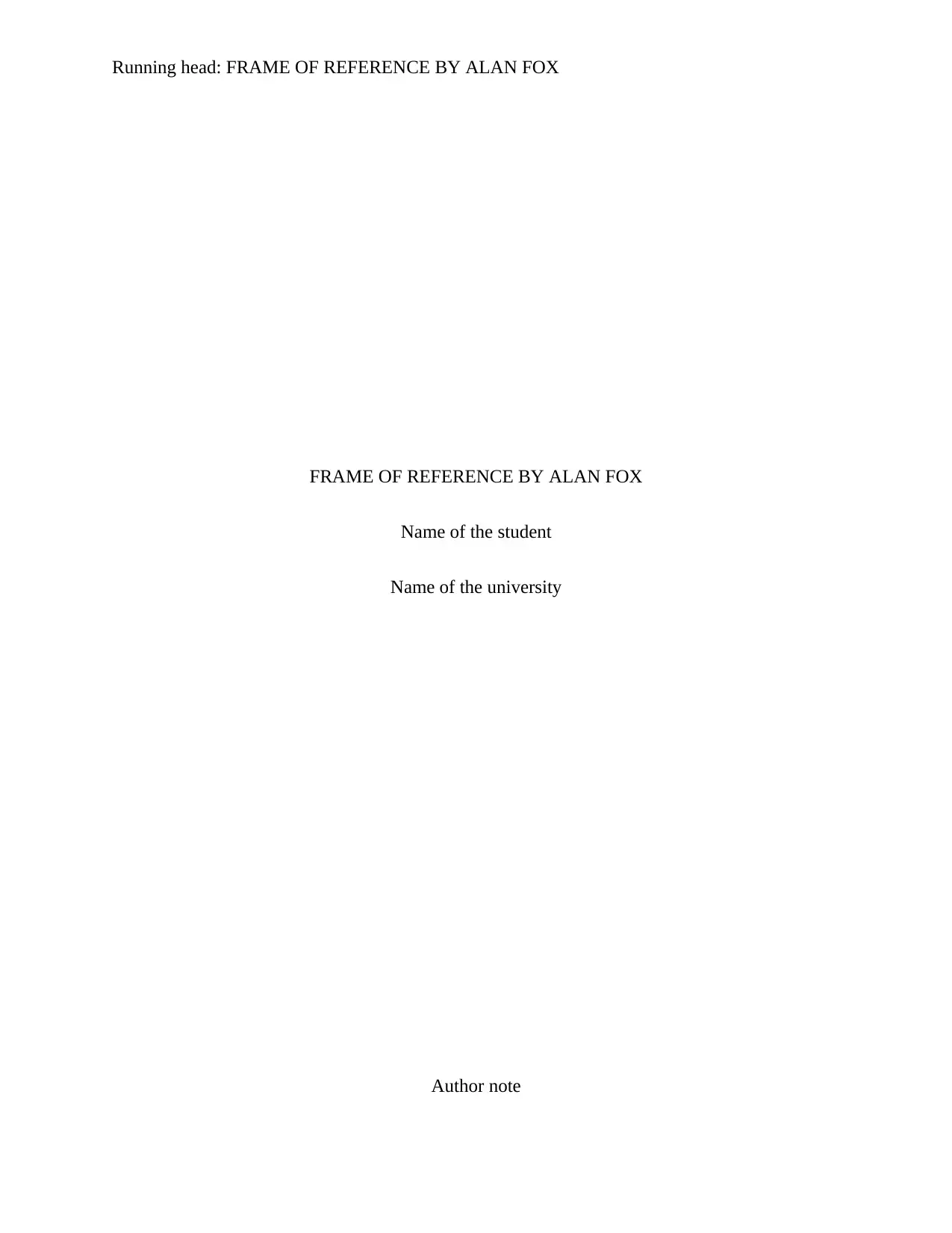
Running head: FRAME OF REFERENCE BY ALAN FOX
FRAME OF REFERENCE BY ALAN FOX
Name of the student
Name of the university
Author note
FRAME OF REFERENCE BY ALAN FOX
Name of the student
Name of the university
Author note
Paraphrase This Document
Need a fresh take? Get an instant paraphrase of this document with our AI Paraphraser
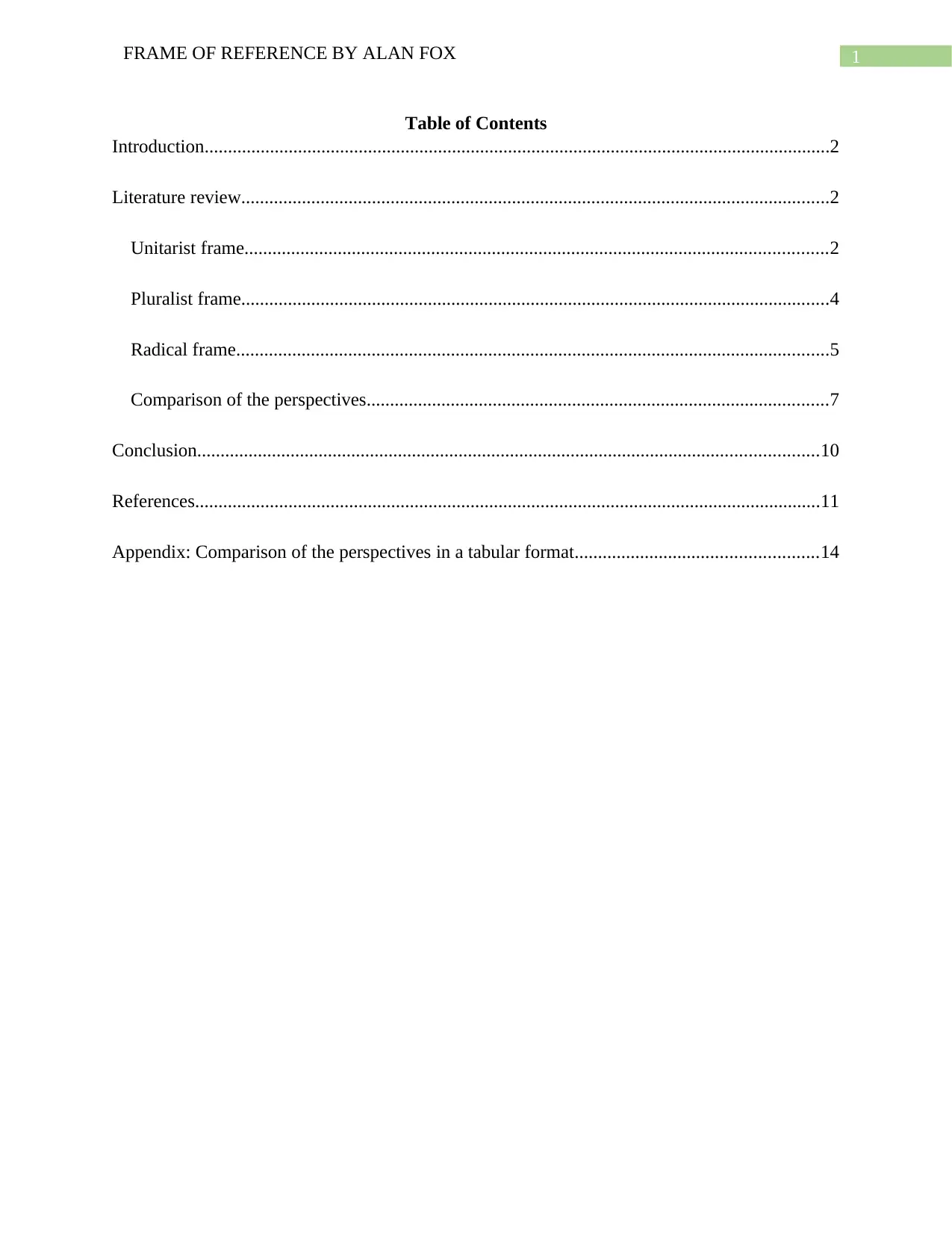
1FRAME OF REFERENCE BY ALAN FOX
Table of Contents
Introduction......................................................................................................................................2
Literature review..............................................................................................................................2
Unitarist frame.............................................................................................................................2
Pluralist frame..............................................................................................................................4
Radical frame...............................................................................................................................5
Comparison of the perspectives...................................................................................................7
Conclusion.....................................................................................................................................10
References......................................................................................................................................11
Appendix: Comparison of the perspectives in a tabular format....................................................14
Table of Contents
Introduction......................................................................................................................................2
Literature review..............................................................................................................................2
Unitarist frame.............................................................................................................................2
Pluralist frame..............................................................................................................................4
Radical frame...............................................................................................................................5
Comparison of the perspectives...................................................................................................7
Conclusion.....................................................................................................................................10
References......................................................................................................................................11
Appendix: Comparison of the perspectives in a tabular format....................................................14
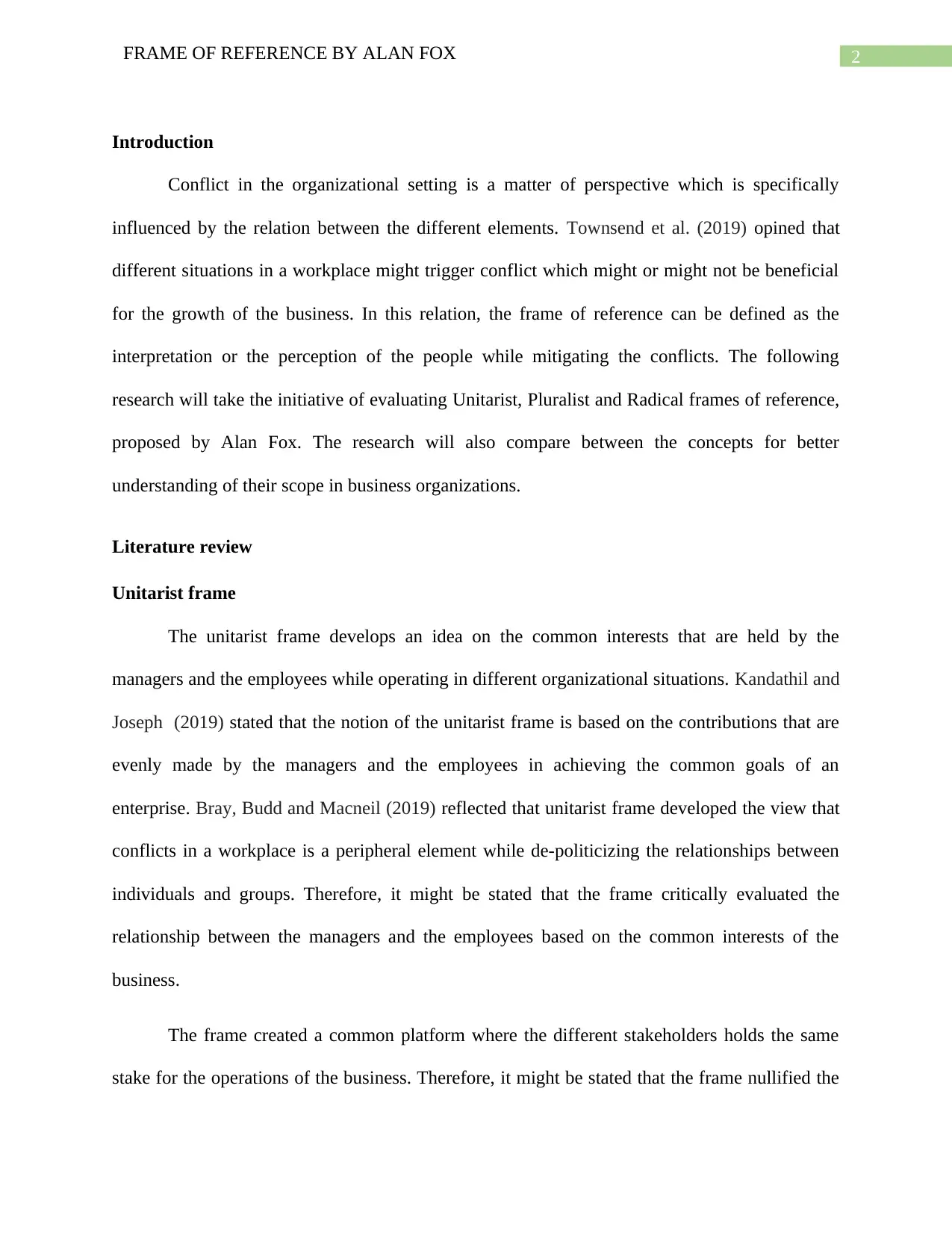
2FRAME OF REFERENCE BY ALAN FOX
Introduction
Conflict in the organizational setting is a matter of perspective which is specifically
influenced by the relation between the different elements. Townsend et al. (2019) opined that
different situations in a workplace might trigger conflict which might or might not be beneficial
for the growth of the business. In this relation, the frame of reference can be defined as the
interpretation or the perception of the people while mitigating the conflicts. The following
research will take the initiative of evaluating Unitarist, Pluralist and Radical frames of reference,
proposed by Alan Fox. The research will also compare between the concepts for better
understanding of their scope in business organizations.
Literature review
Unitarist frame
The unitarist frame develops an idea on the common interests that are held by the
managers and the employees while operating in different organizational situations. Kandathil and
Joseph (2019) stated that the notion of the unitarist frame is based on the contributions that are
evenly made by the managers and the employees in achieving the common goals of an
enterprise. Bray, Budd and Macneil (2019) reflected that unitarist frame developed the view that
conflicts in a workplace is a peripheral element while de-politicizing the relationships between
individuals and groups. Therefore, it might be stated that the frame critically evaluated the
relationship between the managers and the employees based on the common interests of the
business.
The frame created a common platform where the different stakeholders holds the same
stake for the operations of the business. Therefore, it might be stated that the frame nullified the
Introduction
Conflict in the organizational setting is a matter of perspective which is specifically
influenced by the relation between the different elements. Townsend et al. (2019) opined that
different situations in a workplace might trigger conflict which might or might not be beneficial
for the growth of the business. In this relation, the frame of reference can be defined as the
interpretation or the perception of the people while mitigating the conflicts. The following
research will take the initiative of evaluating Unitarist, Pluralist and Radical frames of reference,
proposed by Alan Fox. The research will also compare between the concepts for better
understanding of their scope in business organizations.
Literature review
Unitarist frame
The unitarist frame develops an idea on the common interests that are held by the
managers and the employees while operating in different organizational situations. Kandathil and
Joseph (2019) stated that the notion of the unitarist frame is based on the contributions that are
evenly made by the managers and the employees in achieving the common goals of an
enterprise. Bray, Budd and Macneil (2019) reflected that unitarist frame developed the view that
conflicts in a workplace is a peripheral element while de-politicizing the relationships between
individuals and groups. Therefore, it might be stated that the frame critically evaluated the
relationship between the managers and the employees based on the common interests of the
business.
The frame created a common platform where the different stakeholders holds the same
stake for the operations of the business. Therefore, it might be stated that the frame nullified the
⊘ This is a preview!⊘
Do you want full access?
Subscribe today to unlock all pages.

Trusted by 1+ million students worldwide
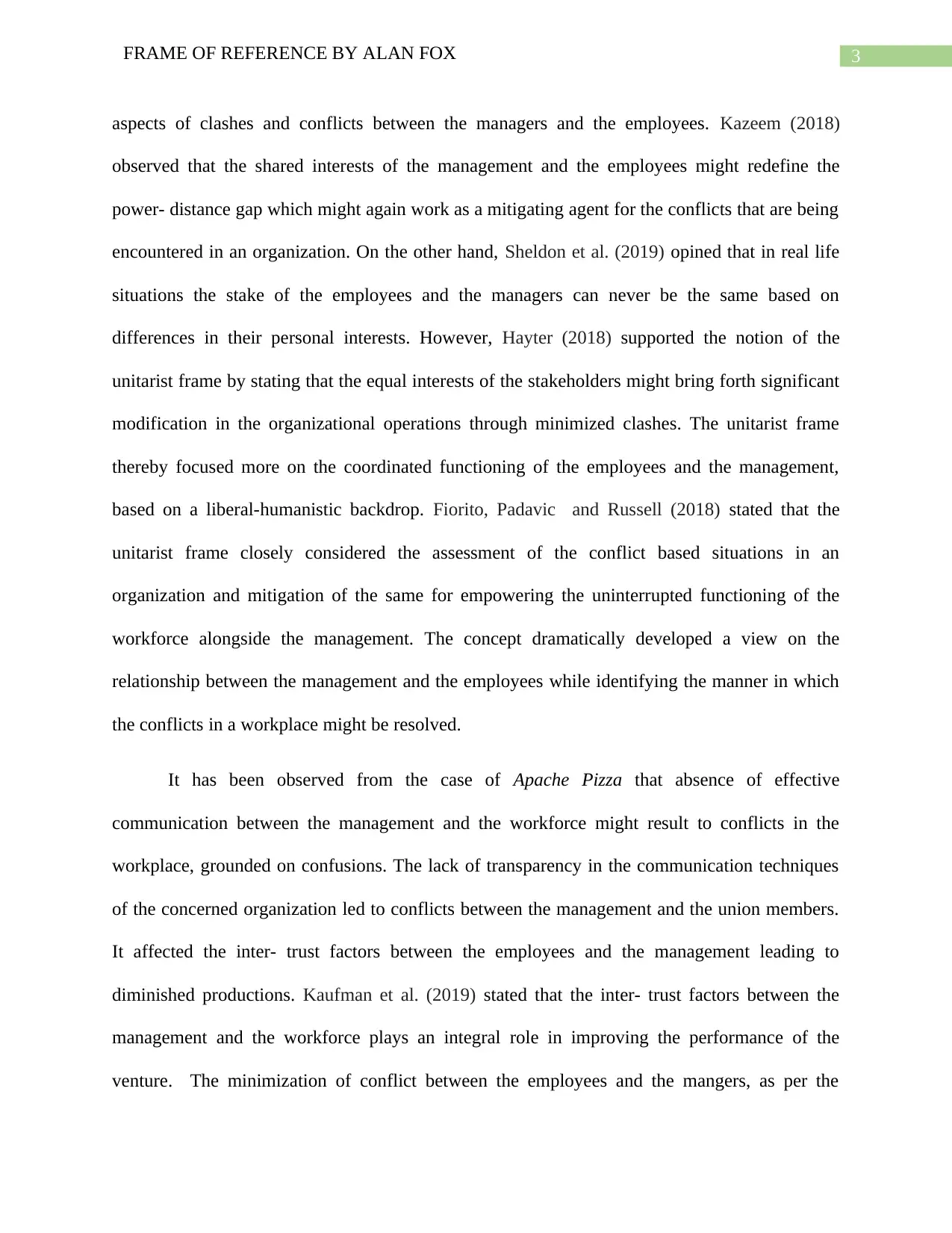
3FRAME OF REFERENCE BY ALAN FOX
aspects of clashes and conflicts between the managers and the employees. Kazeem (2018)
observed that the shared interests of the management and the employees might redefine the
power- distance gap which might again work as a mitigating agent for the conflicts that are being
encountered in an organization. On the other hand, Sheldon et al. (2019) opined that in real life
situations the stake of the employees and the managers can never be the same based on
differences in their personal interests. However, Hayter (2018) supported the notion of the
unitarist frame by stating that the equal interests of the stakeholders might bring forth significant
modification in the organizational operations through minimized clashes. The unitarist frame
thereby focused more on the coordinated functioning of the employees and the management,
based on a liberal-humanistic backdrop. Fiorito, Padavic and Russell (2018) stated that the
unitarist frame closely considered the assessment of the conflict based situations in an
organization and mitigation of the same for empowering the uninterrupted functioning of the
workforce alongside the management. The concept dramatically developed a view on the
relationship between the management and the employees while identifying the manner in which
the conflicts in a workplace might be resolved.
It has been observed from the case of Apache Pizza that absence of effective
communication between the management and the workforce might result to conflicts in the
workplace, grounded on confusions. The lack of transparency in the communication techniques
of the concerned organization led to conflicts between the management and the union members.
It affected the inter- trust factors between the employees and the management leading to
diminished productions. Kaufman et al. (2019) stated that the inter- trust factors between the
management and the workforce plays an integral role in improving the performance of the
venture. The minimization of conflict between the employees and the mangers, as per the
aspects of clashes and conflicts between the managers and the employees. Kazeem (2018)
observed that the shared interests of the management and the employees might redefine the
power- distance gap which might again work as a mitigating agent for the conflicts that are being
encountered in an organization. On the other hand, Sheldon et al. (2019) opined that in real life
situations the stake of the employees and the managers can never be the same based on
differences in their personal interests. However, Hayter (2018) supported the notion of the
unitarist frame by stating that the equal interests of the stakeholders might bring forth significant
modification in the organizational operations through minimized clashes. The unitarist frame
thereby focused more on the coordinated functioning of the employees and the management,
based on a liberal-humanistic backdrop. Fiorito, Padavic and Russell (2018) stated that the
unitarist frame closely considered the assessment of the conflict based situations in an
organization and mitigation of the same for empowering the uninterrupted functioning of the
workforce alongside the management. The concept dramatically developed a view on the
relationship between the management and the employees while identifying the manner in which
the conflicts in a workplace might be resolved.
It has been observed from the case of Apache Pizza that absence of effective
communication between the management and the workforce might result to conflicts in the
workplace, grounded on confusions. The lack of transparency in the communication techniques
of the concerned organization led to conflicts between the management and the union members.
It affected the inter- trust factors between the employees and the management leading to
diminished productions. Kaufman et al. (2019) stated that the inter- trust factors between the
management and the workforce plays an integral role in improving the performance of the
venture. The minimization of conflict between the employees and the mangers, as per the
Paraphrase This Document
Need a fresh take? Get an instant paraphrase of this document with our AI Paraphraser
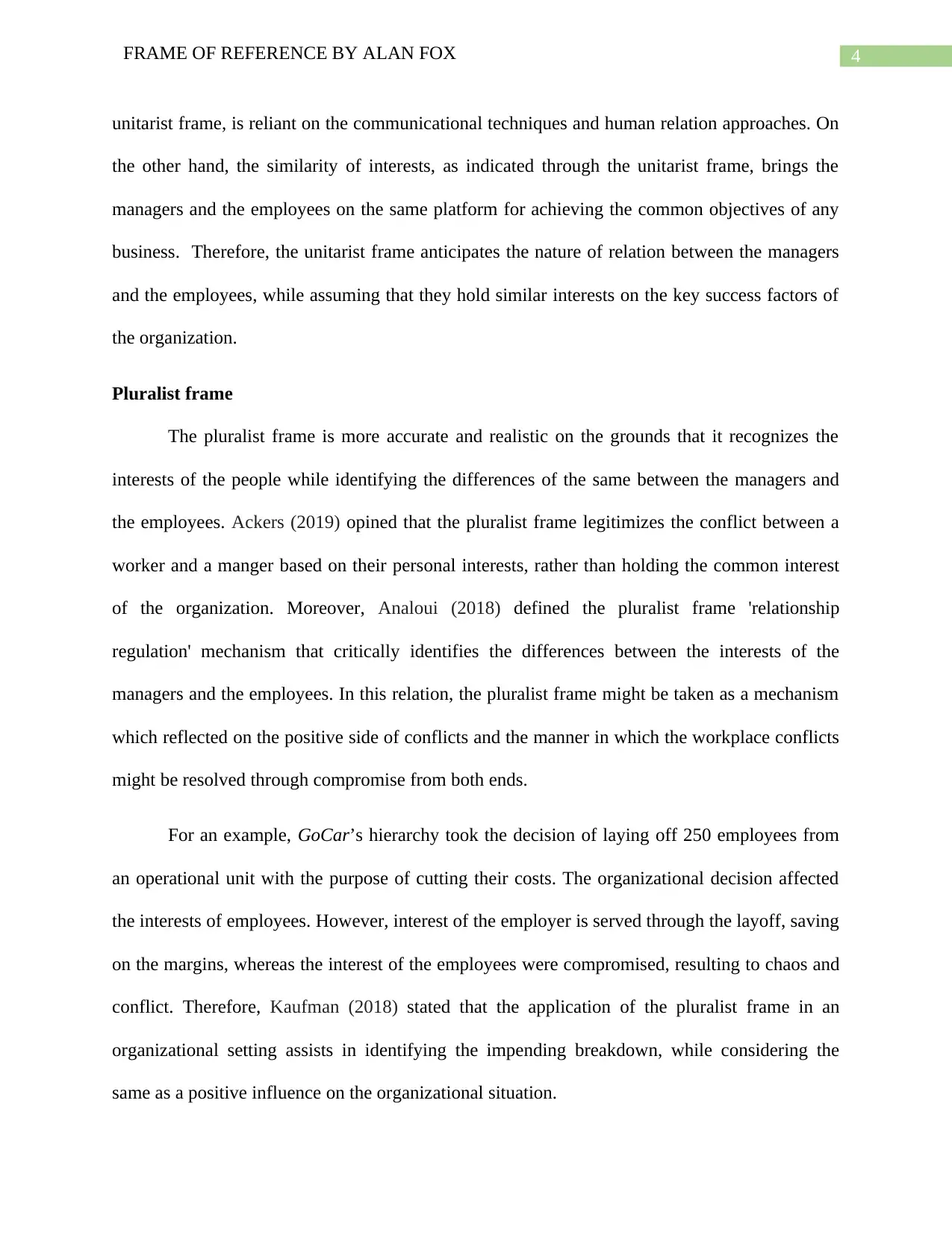
4FRAME OF REFERENCE BY ALAN FOX
unitarist frame, is reliant on the communicational techniques and human relation approaches. On
the other hand, the similarity of interests, as indicated through the unitarist frame, brings the
managers and the employees on the same platform for achieving the common objectives of any
business. Therefore, the unitarist frame anticipates the nature of relation between the managers
and the employees, while assuming that they hold similar interests on the key success factors of
the organization.
Pluralist frame
The pluralist frame is more accurate and realistic on the grounds that it recognizes the
interests of the people while identifying the differences of the same between the managers and
the employees. Ackers (2019) opined that the pluralist frame legitimizes the conflict between a
worker and a manger based on their personal interests, rather than holding the common interest
of the organization. Moreover, Analoui (2018) defined the pluralist frame 'relationship
regulation' mechanism that critically identifies the differences between the interests of the
managers and the employees. In this relation, the pluralist frame might be taken as a mechanism
which reflected on the positive side of conflicts and the manner in which the workplace conflicts
might be resolved through compromise from both ends.
For an example, GoCar’s hierarchy took the decision of laying off 250 employees from
an operational unit with the purpose of cutting their costs. The organizational decision affected
the interests of employees. However, interest of the employer is served through the layoff, saving
on the margins, whereas the interest of the employees were compromised, resulting to chaos and
conflict. Therefore, Kaufman (2018) stated that the application of the pluralist frame in an
organizational setting assists in identifying the impending breakdown, while considering the
same as a positive influence on the organizational situation.
unitarist frame, is reliant on the communicational techniques and human relation approaches. On
the other hand, the similarity of interests, as indicated through the unitarist frame, brings the
managers and the employees on the same platform for achieving the common objectives of any
business. Therefore, the unitarist frame anticipates the nature of relation between the managers
and the employees, while assuming that they hold similar interests on the key success factors of
the organization.
Pluralist frame
The pluralist frame is more accurate and realistic on the grounds that it recognizes the
interests of the people while identifying the differences of the same between the managers and
the employees. Ackers (2019) opined that the pluralist frame legitimizes the conflict between a
worker and a manger based on their personal interests, rather than holding the common interest
of the organization. Moreover, Analoui (2018) defined the pluralist frame 'relationship
regulation' mechanism that critically identifies the differences between the interests of the
managers and the employees. In this relation, the pluralist frame might be taken as a mechanism
which reflected on the positive side of conflicts and the manner in which the workplace conflicts
might be resolved through compromise from both ends.
For an example, GoCar’s hierarchy took the decision of laying off 250 employees from
an operational unit with the purpose of cutting their costs. The organizational decision affected
the interests of employees. However, interest of the employer is served through the layoff, saving
on the margins, whereas the interest of the employees were compromised, resulting to chaos and
conflict. Therefore, Kaufman (2018) stated that the application of the pluralist frame in an
organizational setting assists in identifying the impending breakdown, while considering the
same as a positive influence on the organizational situation.
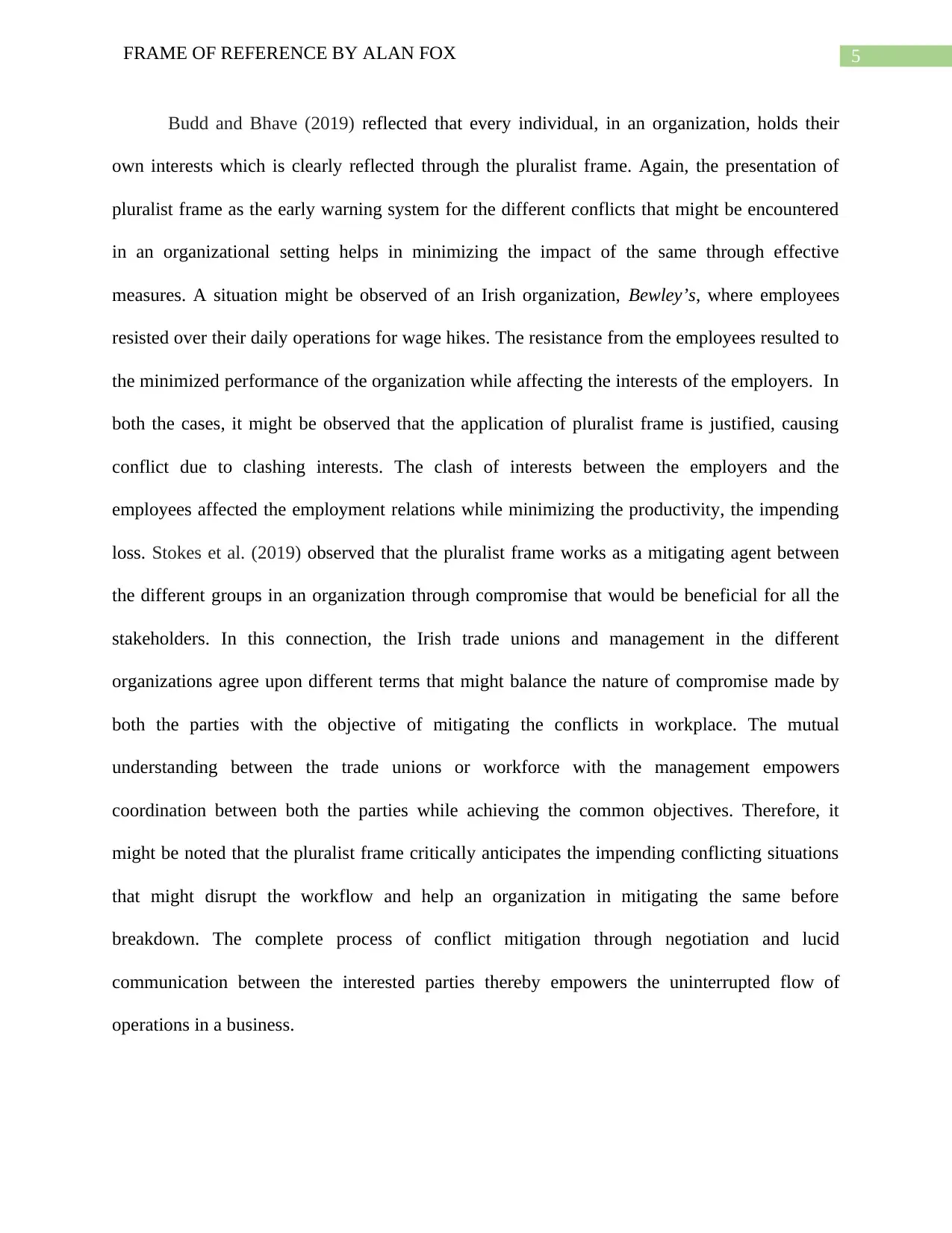
5FRAME OF REFERENCE BY ALAN FOX
Budd and Bhave (2019) reflected that every individual, in an organization, holds their
own interests which is clearly reflected through the pluralist frame. Again, the presentation of
pluralist frame as the early warning system for the different conflicts that might be encountered
in an organizational setting helps in minimizing the impact of the same through effective
measures. A situation might be observed of an Irish organization, Bewley’s, where employees
resisted over their daily operations for wage hikes. The resistance from the employees resulted to
the minimized performance of the organization while affecting the interests of the employers. In
both the cases, it might be observed that the application of pluralist frame is justified, causing
conflict due to clashing interests. The clash of interests between the employers and the
employees affected the employment relations while minimizing the productivity, the impending
loss. Stokes et al. (2019) observed that the pluralist frame works as a mitigating agent between
the different groups in an organization through compromise that would be beneficial for all the
stakeholders. In this connection, the Irish trade unions and management in the different
organizations agree upon different terms that might balance the nature of compromise made by
both the parties with the objective of mitigating the conflicts in workplace. The mutual
understanding between the trade unions or workforce with the management empowers
coordination between both the parties while achieving the common objectives. Therefore, it
might be noted that the pluralist frame critically anticipates the impending conflicting situations
that might disrupt the workflow and help an organization in mitigating the same before
breakdown. The complete process of conflict mitigation through negotiation and lucid
communication between the interested parties thereby empowers the uninterrupted flow of
operations in a business.
Budd and Bhave (2019) reflected that every individual, in an organization, holds their
own interests which is clearly reflected through the pluralist frame. Again, the presentation of
pluralist frame as the early warning system for the different conflicts that might be encountered
in an organizational setting helps in minimizing the impact of the same through effective
measures. A situation might be observed of an Irish organization, Bewley’s, where employees
resisted over their daily operations for wage hikes. The resistance from the employees resulted to
the minimized performance of the organization while affecting the interests of the employers. In
both the cases, it might be observed that the application of pluralist frame is justified, causing
conflict due to clashing interests. The clash of interests between the employers and the
employees affected the employment relations while minimizing the productivity, the impending
loss. Stokes et al. (2019) observed that the pluralist frame works as a mitigating agent between
the different groups in an organization through compromise that would be beneficial for all the
stakeholders. In this connection, the Irish trade unions and management in the different
organizations agree upon different terms that might balance the nature of compromise made by
both the parties with the objective of mitigating the conflicts in workplace. The mutual
understanding between the trade unions or workforce with the management empowers
coordination between both the parties while achieving the common objectives. Therefore, it
might be noted that the pluralist frame critically anticipates the impending conflicting situations
that might disrupt the workflow and help an organization in mitigating the same before
breakdown. The complete process of conflict mitigation through negotiation and lucid
communication between the interested parties thereby empowers the uninterrupted flow of
operations in a business.
⊘ This is a preview!⊘
Do you want full access?
Subscribe today to unlock all pages.

Trusted by 1+ million students worldwide
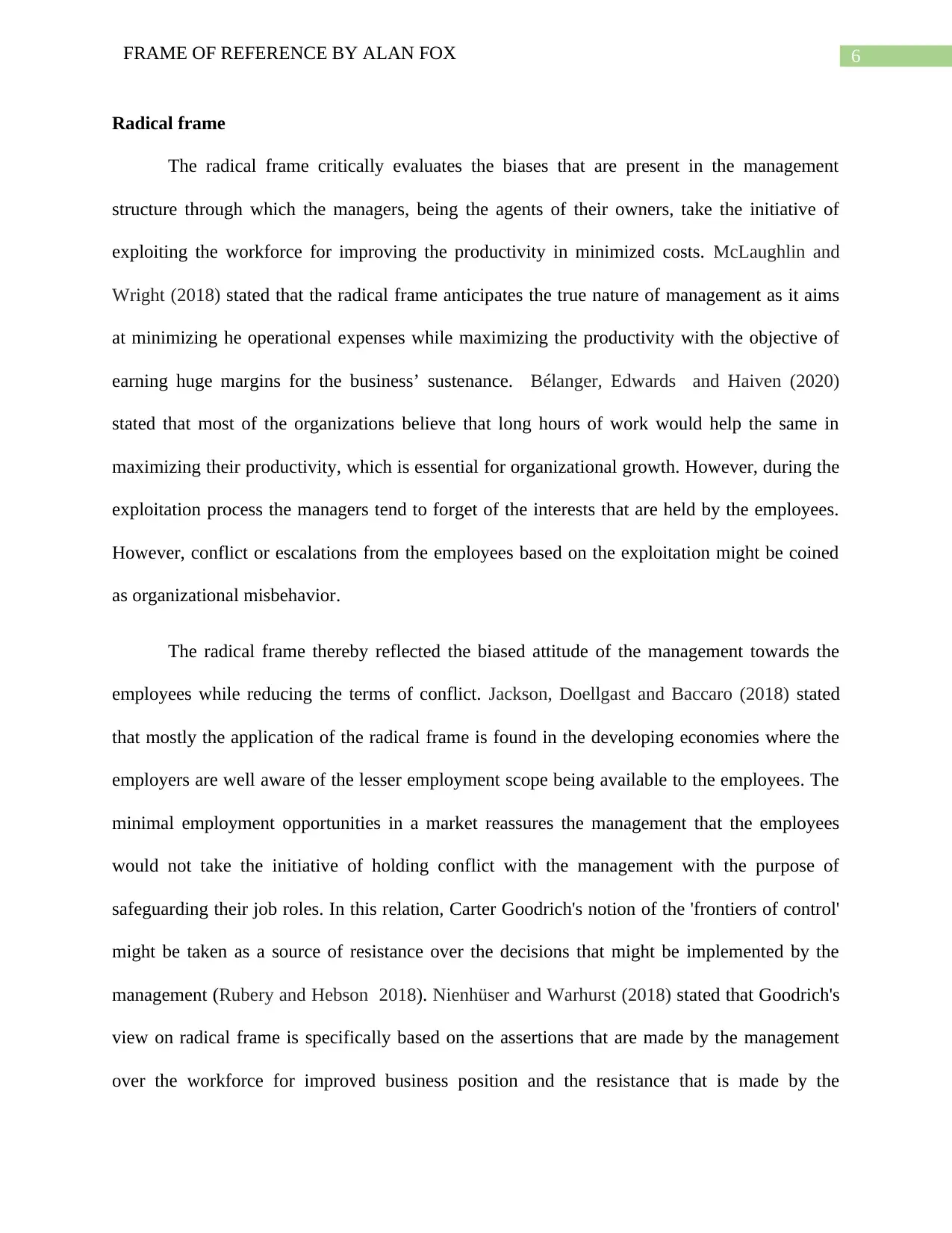
6FRAME OF REFERENCE BY ALAN FOX
Radical frame
The radical frame critically evaluates the biases that are present in the management
structure through which the managers, being the agents of their owners, take the initiative of
exploiting the workforce for improving the productivity in minimized costs. McLaughlin and
Wright (2018) stated that the radical frame anticipates the true nature of management as it aims
at minimizing he operational expenses while maximizing the productivity with the objective of
earning huge margins for the business’ sustenance. Bélanger, Edwards and Haiven (2020)
stated that most of the organizations believe that long hours of work would help the same in
maximizing their productivity, which is essential for organizational growth. However, during the
exploitation process the managers tend to forget of the interests that are held by the employees.
However, conflict or escalations from the employees based on the exploitation might be coined
as organizational misbehavior.
The radical frame thereby reflected the biased attitude of the management towards the
employees while reducing the terms of conflict. Jackson, Doellgast and Baccaro (2018) stated
that mostly the application of the radical frame is found in the developing economies where the
employers are well aware of the lesser employment scope being available to the employees. The
minimal employment opportunities in a market reassures the management that the employees
would not take the initiative of holding conflict with the management with the purpose of
safeguarding their job roles. In this relation, Carter Goodrich's notion of the 'frontiers of control'
might be taken as a source of resistance over the decisions that might be implemented by the
management (Rubery and Hebson 2018). Nienhüser and Warhurst (2018) stated that Goodrich's
view on radical frame is specifically based on the assertions that are made by the management
over the workforce for improved business position and the resistance that is made by the
Radical frame
The radical frame critically evaluates the biases that are present in the management
structure through which the managers, being the agents of their owners, take the initiative of
exploiting the workforce for improving the productivity in minimized costs. McLaughlin and
Wright (2018) stated that the radical frame anticipates the true nature of management as it aims
at minimizing he operational expenses while maximizing the productivity with the objective of
earning huge margins for the business’ sustenance. Bélanger, Edwards and Haiven (2020)
stated that most of the organizations believe that long hours of work would help the same in
maximizing their productivity, which is essential for organizational growth. However, during the
exploitation process the managers tend to forget of the interests that are held by the employees.
However, conflict or escalations from the employees based on the exploitation might be coined
as organizational misbehavior.
The radical frame thereby reflected the biased attitude of the management towards the
employees while reducing the terms of conflict. Jackson, Doellgast and Baccaro (2018) stated
that mostly the application of the radical frame is found in the developing economies where the
employers are well aware of the lesser employment scope being available to the employees. The
minimal employment opportunities in a market reassures the management that the employees
would not take the initiative of holding conflict with the management with the purpose of
safeguarding their job roles. In this relation, Carter Goodrich's notion of the 'frontiers of control'
might be taken as a source of resistance over the decisions that might be implemented by the
management (Rubery and Hebson 2018). Nienhüser and Warhurst (2018) stated that Goodrich's
view on radical frame is specifically based on the assertions that are made by the management
over the workforce for improved business position and the resistance that is made by the
Paraphrase This Document
Need a fresh take? Get an instant paraphrase of this document with our AI Paraphraser
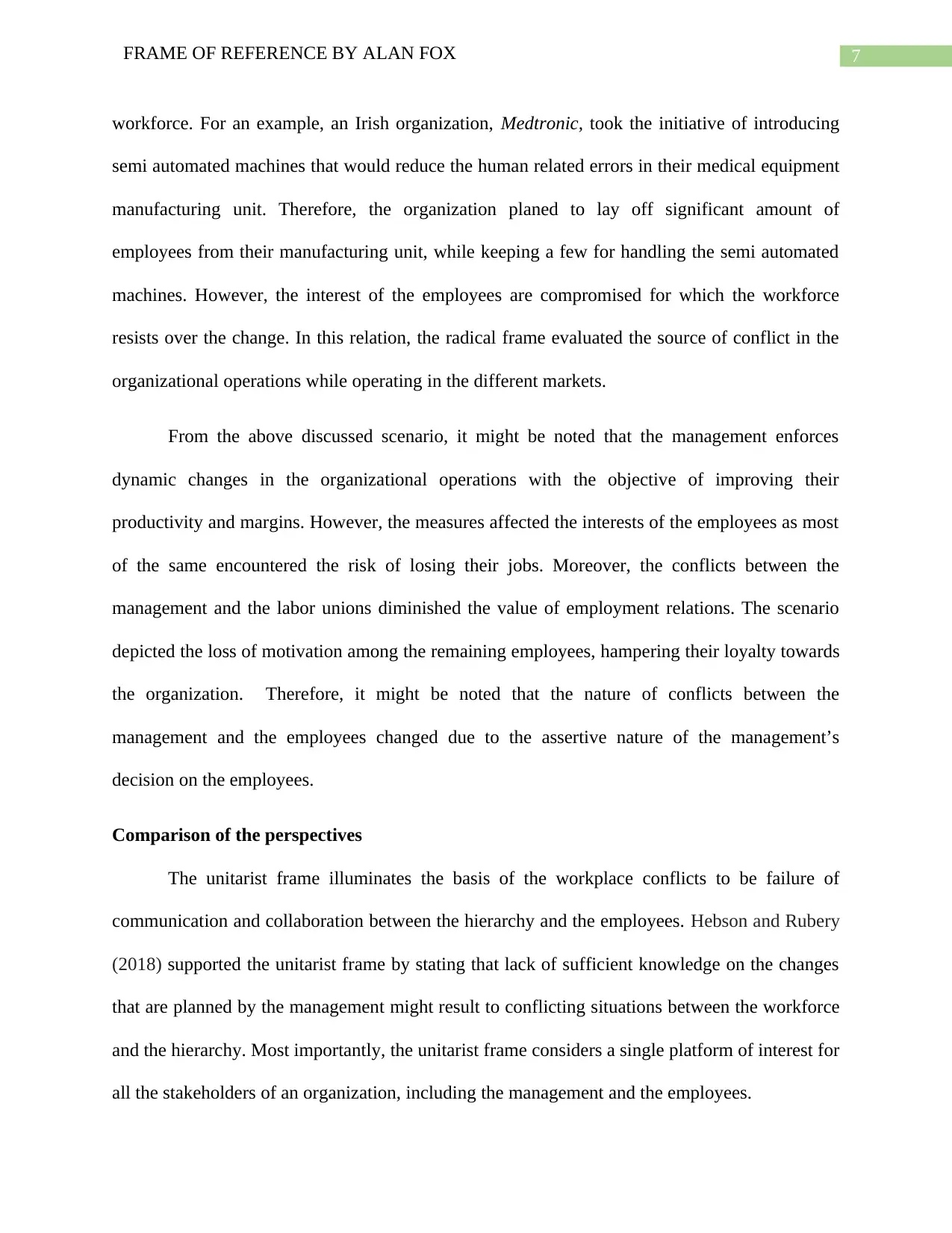
7FRAME OF REFERENCE BY ALAN FOX
workforce. For an example, an Irish organization, Medtronic, took the initiative of introducing
semi automated machines that would reduce the human related errors in their medical equipment
manufacturing unit. Therefore, the organization planed to lay off significant amount of
employees from their manufacturing unit, while keeping a few for handling the semi automated
machines. However, the interest of the employees are compromised for which the workforce
resists over the change. In this relation, the radical frame evaluated the source of conflict in the
organizational operations while operating in the different markets.
From the above discussed scenario, it might be noted that the management enforces
dynamic changes in the organizational operations with the objective of improving their
productivity and margins. However, the measures affected the interests of the employees as most
of the same encountered the risk of losing their jobs. Moreover, the conflicts between the
management and the labor unions diminished the value of employment relations. The scenario
depicted the loss of motivation among the remaining employees, hampering their loyalty towards
the organization. Therefore, it might be noted that the nature of conflicts between the
management and the employees changed due to the assertive nature of the management’s
decision on the employees.
Comparison of the perspectives
The unitarist frame illuminates the basis of the workplace conflicts to be failure of
communication and collaboration between the hierarchy and the employees. Hebson and Rubery
(2018) supported the unitarist frame by stating that lack of sufficient knowledge on the changes
that are planned by the management might result to conflicting situations between the workforce
and the hierarchy. Most importantly, the unitarist frame considers a single platform of interest for
all the stakeholders of an organization, including the management and the employees.
workforce. For an example, an Irish organization, Medtronic, took the initiative of introducing
semi automated machines that would reduce the human related errors in their medical equipment
manufacturing unit. Therefore, the organization planed to lay off significant amount of
employees from their manufacturing unit, while keeping a few for handling the semi automated
machines. However, the interest of the employees are compromised for which the workforce
resists over the change. In this relation, the radical frame evaluated the source of conflict in the
organizational operations while operating in the different markets.
From the above discussed scenario, it might be noted that the management enforces
dynamic changes in the organizational operations with the objective of improving their
productivity and margins. However, the measures affected the interests of the employees as most
of the same encountered the risk of losing their jobs. Moreover, the conflicts between the
management and the labor unions diminished the value of employment relations. The scenario
depicted the loss of motivation among the remaining employees, hampering their loyalty towards
the organization. Therefore, it might be noted that the nature of conflicts between the
management and the employees changed due to the assertive nature of the management’s
decision on the employees.
Comparison of the perspectives
The unitarist frame illuminates the basis of the workplace conflicts to be failure of
communication and collaboration between the hierarchy and the employees. Hebson and Rubery
(2018) supported the unitarist frame by stating that lack of sufficient knowledge on the changes
that are planned by the management might result to conflicting situations between the workforce
and the hierarchy. Most importantly, the unitarist frame considers a single platform of interest for
all the stakeholders of an organization, including the management and the employees.
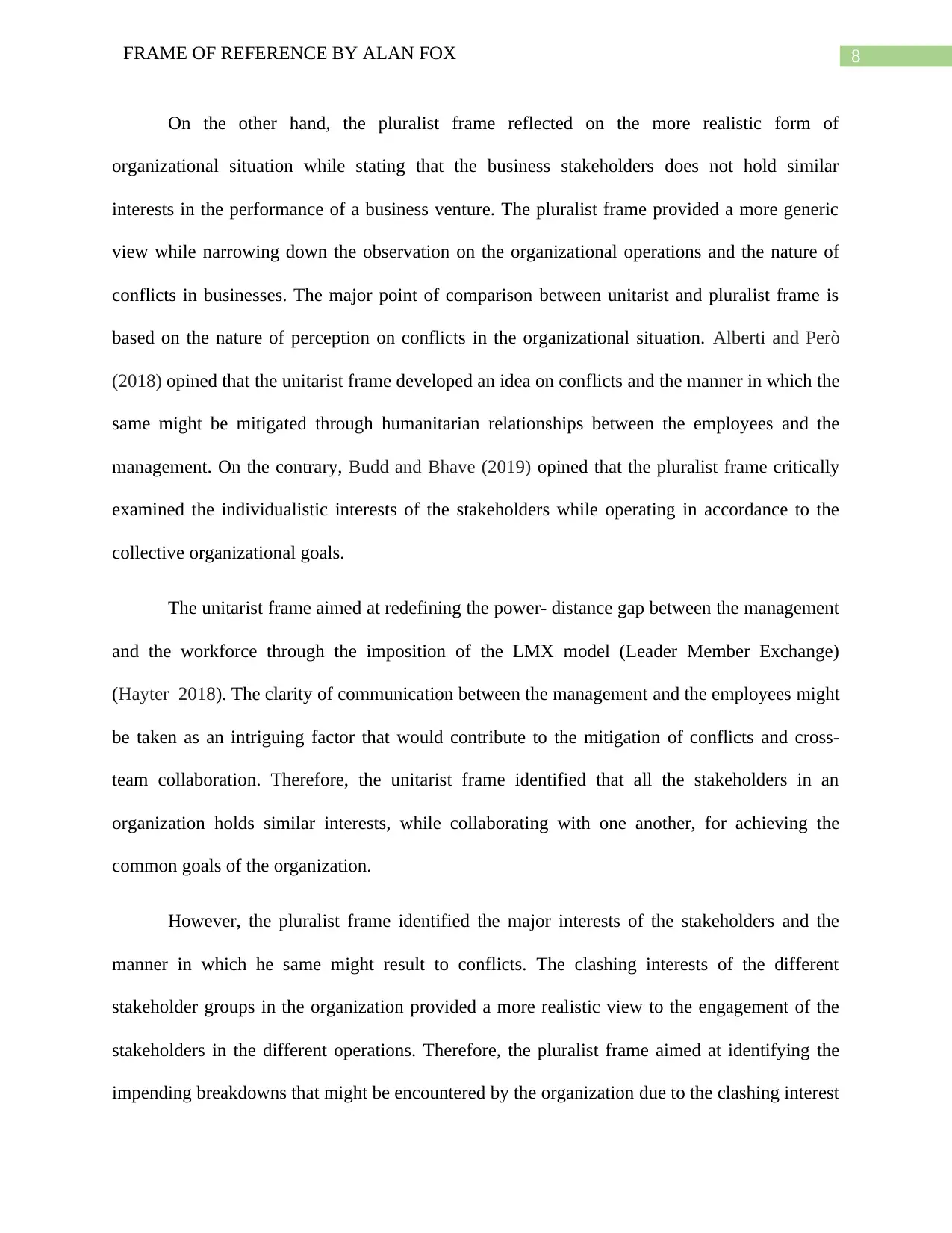
8FRAME OF REFERENCE BY ALAN FOX
On the other hand, the pluralist frame reflected on the more realistic form of
organizational situation while stating that the business stakeholders does not hold similar
interests in the performance of a business venture. The pluralist frame provided a more generic
view while narrowing down the observation on the organizational operations and the nature of
conflicts in businesses. The major point of comparison between unitarist and pluralist frame is
based on the nature of perception on conflicts in the organizational situation. Alberti and Però
(2018) opined that the unitarist frame developed an idea on conflicts and the manner in which the
same might be mitigated through humanitarian relationships between the employees and the
management. On the contrary, Budd and Bhave (2019) opined that the pluralist frame critically
examined the individualistic interests of the stakeholders while operating in accordance to the
collective organizational goals.
The unitarist frame aimed at redefining the power- distance gap between the management
and the workforce through the imposition of the LMX model (Leader Member Exchange)
(Hayter 2018). The clarity of communication between the management and the employees might
be taken as an intriguing factor that would contribute to the mitigation of conflicts and cross-
team collaboration. Therefore, the unitarist frame identified that all the stakeholders in an
organization holds similar interests, while collaborating with one another, for achieving the
common goals of the organization.
However, the pluralist frame identified the major interests of the stakeholders and the
manner in which he same might result to conflicts. The clashing interests of the different
stakeholder groups in the organization provided a more realistic view to the engagement of the
stakeholders in the different operations. Therefore, the pluralist frame aimed at identifying the
impending breakdowns that might be encountered by the organization due to the clashing interest
On the other hand, the pluralist frame reflected on the more realistic form of
organizational situation while stating that the business stakeholders does not hold similar
interests in the performance of a business venture. The pluralist frame provided a more generic
view while narrowing down the observation on the organizational operations and the nature of
conflicts in businesses. The major point of comparison between unitarist and pluralist frame is
based on the nature of perception on conflicts in the organizational situation. Alberti and Però
(2018) opined that the unitarist frame developed an idea on conflicts and the manner in which the
same might be mitigated through humanitarian relationships between the employees and the
management. On the contrary, Budd and Bhave (2019) opined that the pluralist frame critically
examined the individualistic interests of the stakeholders while operating in accordance to the
collective organizational goals.
The unitarist frame aimed at redefining the power- distance gap between the management
and the workforce through the imposition of the LMX model (Leader Member Exchange)
(Hayter 2018). The clarity of communication between the management and the employees might
be taken as an intriguing factor that would contribute to the mitigation of conflicts and cross-
team collaboration. Therefore, the unitarist frame identified that all the stakeholders in an
organization holds similar interests, while collaborating with one another, for achieving the
common goals of the organization.
However, the pluralist frame identified the major interests of the stakeholders and the
manner in which he same might result to conflicts. The clashing interests of the different
stakeholder groups in the organization provided a more realistic view to the engagement of the
stakeholders in the different operations. Therefore, the pluralist frame aimed at identifying the
impending breakdowns that might be encountered by the organization due to the clashing interest
⊘ This is a preview!⊘
Do you want full access?
Subscribe today to unlock all pages.

Trusted by 1+ million students worldwide
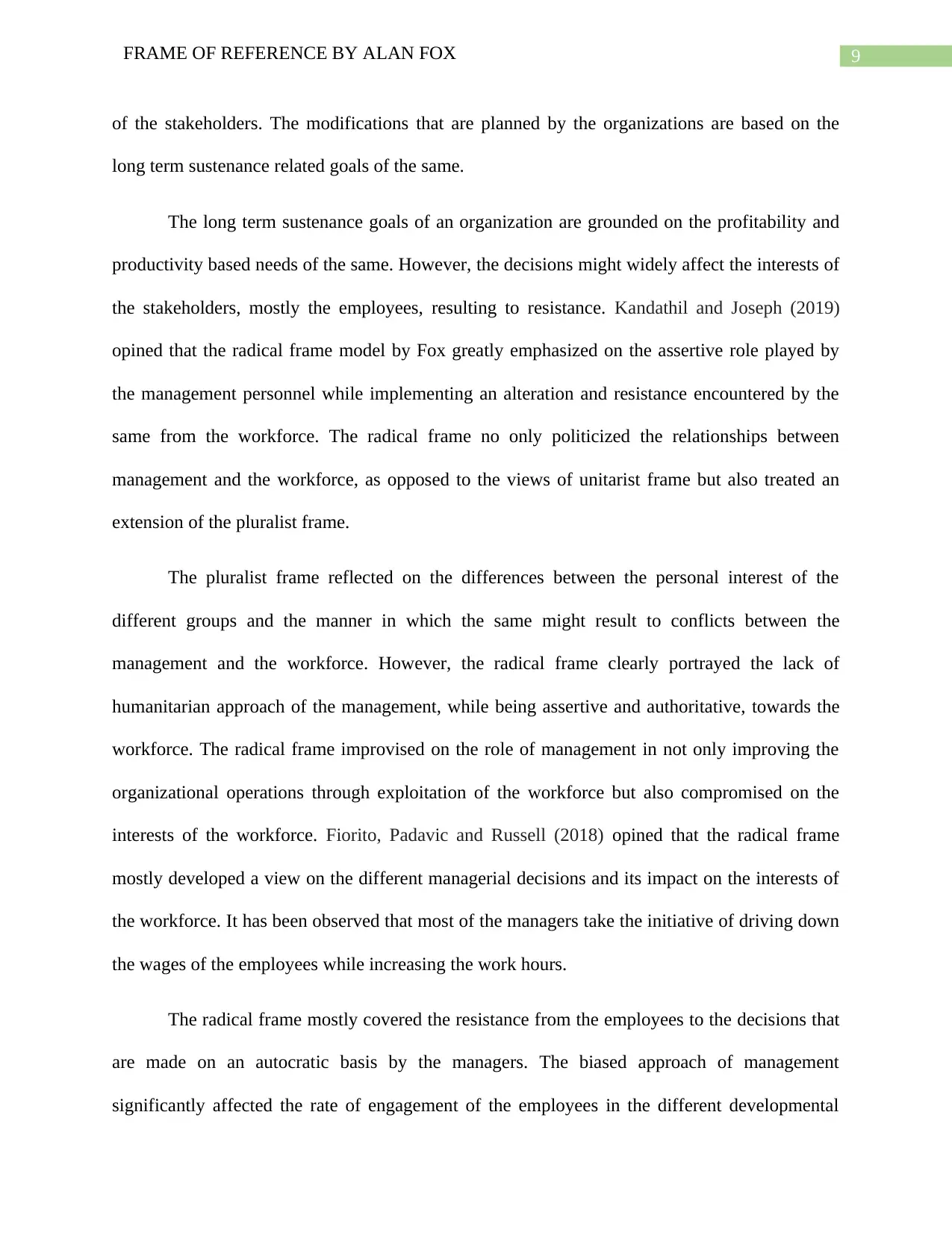
9FRAME OF REFERENCE BY ALAN FOX
of the stakeholders. The modifications that are planned by the organizations are based on the
long term sustenance related goals of the same.
The long term sustenance goals of an organization are grounded on the profitability and
productivity based needs of the same. However, the decisions might widely affect the interests of
the stakeholders, mostly the employees, resulting to resistance. Kandathil and Joseph (2019)
opined that the radical frame model by Fox greatly emphasized on the assertive role played by
the management personnel while implementing an alteration and resistance encountered by the
same from the workforce. The radical frame no only politicized the relationships between
management and the workforce, as opposed to the views of unitarist frame but also treated an
extension of the pluralist frame.
The pluralist frame reflected on the differences between the personal interest of the
different groups and the manner in which the same might result to conflicts between the
management and the workforce. However, the radical frame clearly portrayed the lack of
humanitarian approach of the management, while being assertive and authoritative, towards the
workforce. The radical frame improvised on the role of management in not only improving the
organizational operations through exploitation of the workforce but also compromised on the
interests of the workforce. Fiorito, Padavic and Russell (2018) opined that the radical frame
mostly developed a view on the different managerial decisions and its impact on the interests of
the workforce. It has been observed that most of the managers take the initiative of driving down
the wages of the employees while increasing the work hours.
The radical frame mostly covered the resistance from the employees to the decisions that
are made on an autocratic basis by the managers. The biased approach of management
significantly affected the rate of engagement of the employees in the different developmental
of the stakeholders. The modifications that are planned by the organizations are based on the
long term sustenance related goals of the same.
The long term sustenance goals of an organization are grounded on the profitability and
productivity based needs of the same. However, the decisions might widely affect the interests of
the stakeholders, mostly the employees, resulting to resistance. Kandathil and Joseph (2019)
opined that the radical frame model by Fox greatly emphasized on the assertive role played by
the management personnel while implementing an alteration and resistance encountered by the
same from the workforce. The radical frame no only politicized the relationships between
management and the workforce, as opposed to the views of unitarist frame but also treated an
extension of the pluralist frame.
The pluralist frame reflected on the differences between the personal interest of the
different groups and the manner in which the same might result to conflicts between the
management and the workforce. However, the radical frame clearly portrayed the lack of
humanitarian approach of the management, while being assertive and authoritative, towards the
workforce. The radical frame improvised on the role of management in not only improving the
organizational operations through exploitation of the workforce but also compromised on the
interests of the workforce. Fiorito, Padavic and Russell (2018) opined that the radical frame
mostly developed a view on the different managerial decisions and its impact on the interests of
the workforce. It has been observed that most of the managers take the initiative of driving down
the wages of the employees while increasing the work hours.
The radical frame mostly covered the resistance from the employees to the decisions that
are made on an autocratic basis by the managers. The biased approach of management
significantly affected the rate of engagement of the employees in the different developmental
Paraphrase This Document
Need a fresh take? Get an instant paraphrase of this document with our AI Paraphraser
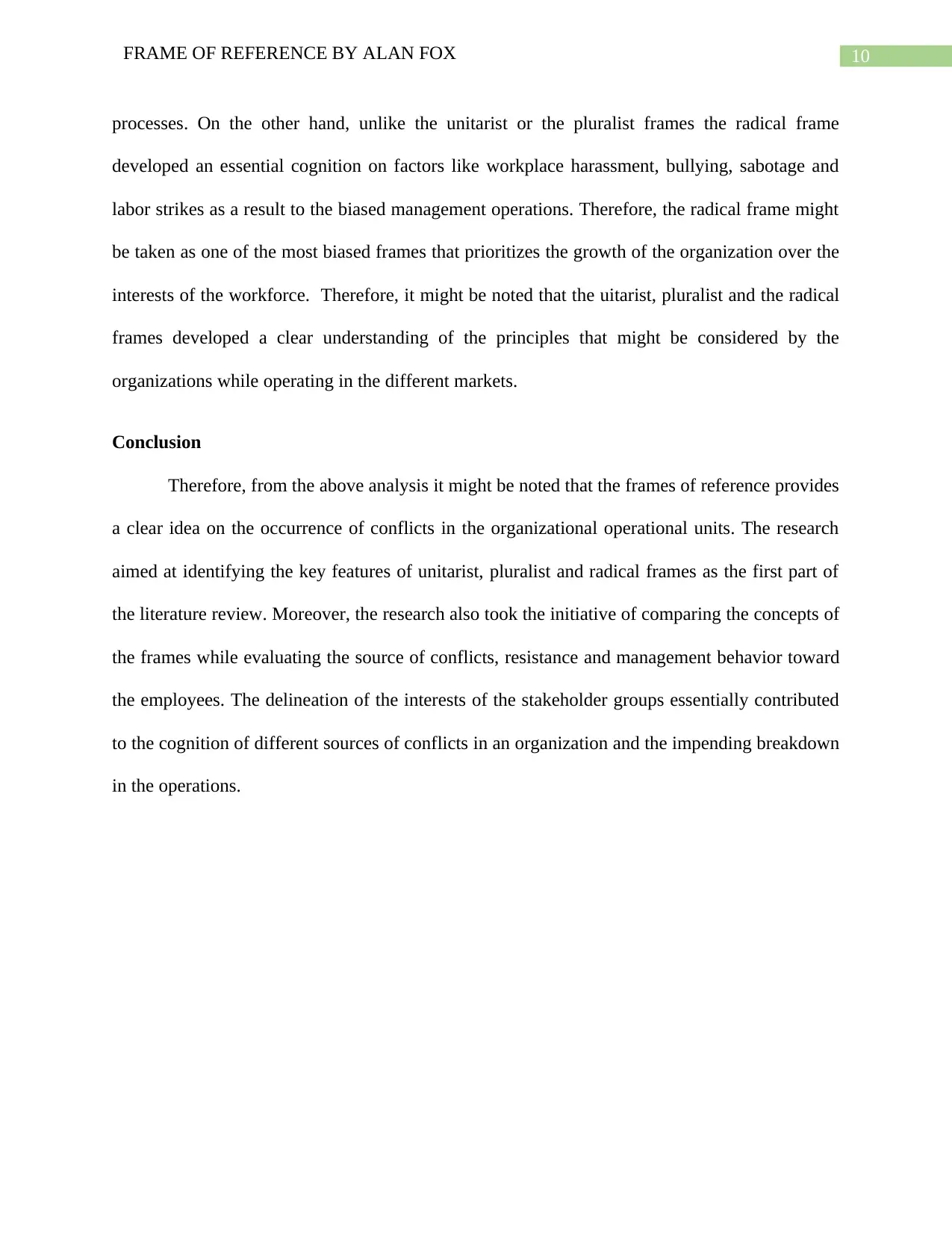
10FRAME OF REFERENCE BY ALAN FOX
processes. On the other hand, unlike the unitarist or the pluralist frames the radical frame
developed an essential cognition on factors like workplace harassment, bullying, sabotage and
labor strikes as a result to the biased management operations. Therefore, the radical frame might
be taken as one of the most biased frames that prioritizes the growth of the organization over the
interests of the workforce. Therefore, it might be noted that the uitarist, pluralist and the radical
frames developed a clear understanding of the principles that might be considered by the
organizations while operating in the different markets.
Conclusion
Therefore, from the above analysis it might be noted that the frames of reference provides
a clear idea on the occurrence of conflicts in the organizational operational units. The research
aimed at identifying the key features of unitarist, pluralist and radical frames as the first part of
the literature review. Moreover, the research also took the initiative of comparing the concepts of
the frames while evaluating the source of conflicts, resistance and management behavior toward
the employees. The delineation of the interests of the stakeholder groups essentially contributed
to the cognition of different sources of conflicts in an organization and the impending breakdown
in the operations.
processes. On the other hand, unlike the unitarist or the pluralist frames the radical frame
developed an essential cognition on factors like workplace harassment, bullying, sabotage and
labor strikes as a result to the biased management operations. Therefore, the radical frame might
be taken as one of the most biased frames that prioritizes the growth of the organization over the
interests of the workforce. Therefore, it might be noted that the uitarist, pluralist and the radical
frames developed a clear understanding of the principles that might be considered by the
organizations while operating in the different markets.
Conclusion
Therefore, from the above analysis it might be noted that the frames of reference provides
a clear idea on the occurrence of conflicts in the organizational operational units. The research
aimed at identifying the key features of unitarist, pluralist and radical frames as the first part of
the literature review. Moreover, the research also took the initiative of comparing the concepts of
the frames while evaluating the source of conflicts, resistance and management behavior toward
the employees. The delineation of the interests of the stakeholder groups essentially contributed
to the cognition of different sources of conflicts in an organization and the impending breakdown
in the operations.
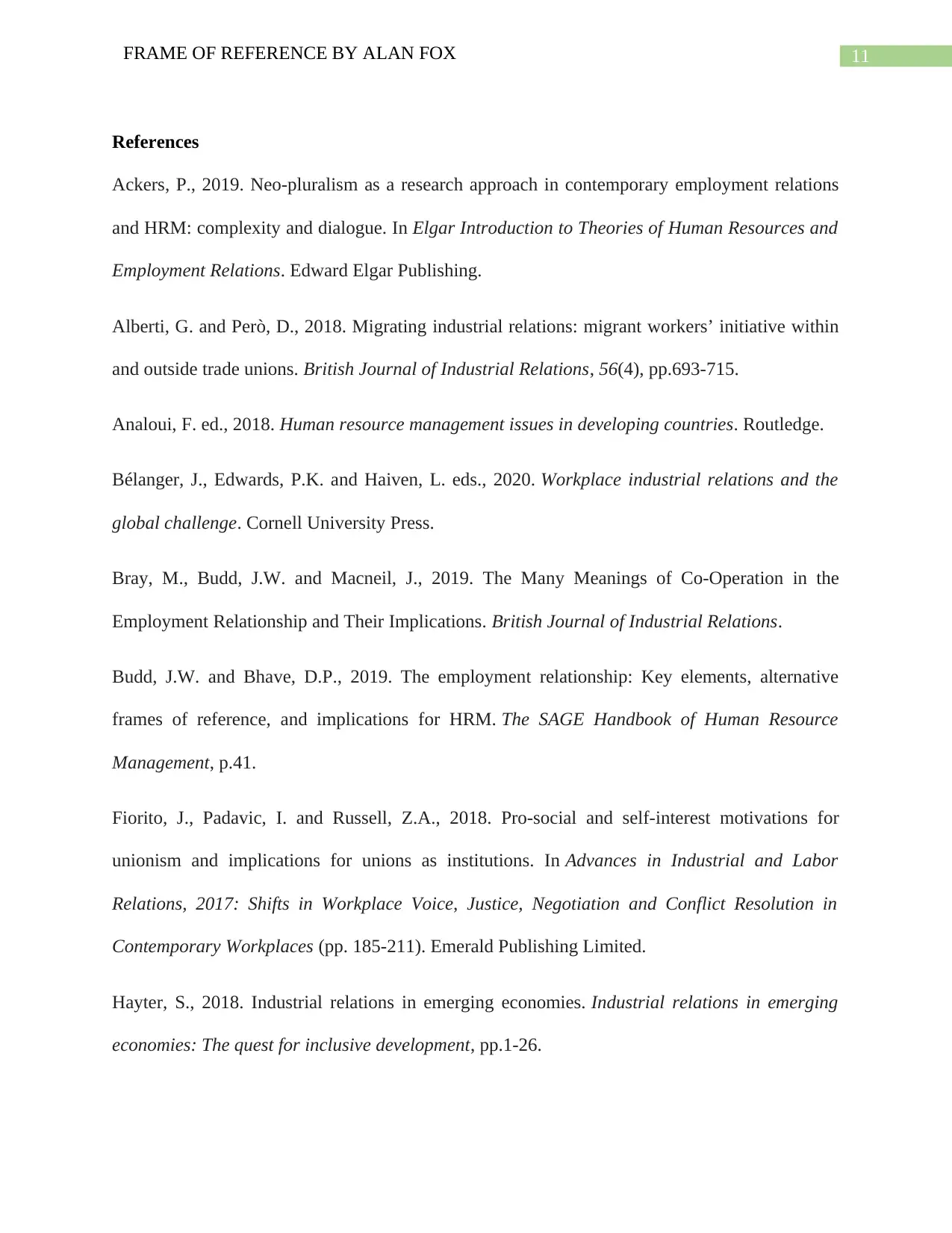
11FRAME OF REFERENCE BY ALAN FOX
References
Ackers, P., 2019. Neo-pluralism as a research approach in contemporary employment relations
and HRM: complexity and dialogue. In Elgar Introduction to Theories of Human Resources and
Employment Relations. Edward Elgar Publishing.
Alberti, G. and Però, D., 2018. Migrating industrial relations: migrant workers’ initiative within
and outside trade unions. British Journal of Industrial Relations, 56(4), pp.693-715.
Analoui, F. ed., 2018. Human resource management issues in developing countries. Routledge.
Bélanger, J., Edwards, P.K. and Haiven, L. eds., 2020. Workplace industrial relations and the
global challenge. Cornell University Press.
Bray, M., Budd, J.W. and Macneil, J., 2019. The Many Meanings of Co‐Operation in the
Employment Relationship and Their Implications. British Journal of Industrial Relations.
Budd, J.W. and Bhave, D.P., 2019. The employment relationship: Key elements, alternative
frames of reference, and implications for HRM. The SAGE Handbook of Human Resource
Management, p.41.
Fiorito, J., Padavic, I. and Russell, Z.A., 2018. Pro-social and self-interest motivations for
unionism and implications for unions as institutions. In Advances in Industrial and Labor
Relations, 2017: Shifts in Workplace Voice, Justice, Negotiation and Conflict Resolution in
Contemporary Workplaces (pp. 185-211). Emerald Publishing Limited.
Hayter, S., 2018. Industrial relations in emerging economies. Industrial relations in emerging
economies: The quest for inclusive development, pp.1-26.
References
Ackers, P., 2019. Neo-pluralism as a research approach in contemporary employment relations
and HRM: complexity and dialogue. In Elgar Introduction to Theories of Human Resources and
Employment Relations. Edward Elgar Publishing.
Alberti, G. and Però, D., 2018. Migrating industrial relations: migrant workers’ initiative within
and outside trade unions. British Journal of Industrial Relations, 56(4), pp.693-715.
Analoui, F. ed., 2018. Human resource management issues in developing countries. Routledge.
Bélanger, J., Edwards, P.K. and Haiven, L. eds., 2020. Workplace industrial relations and the
global challenge. Cornell University Press.
Bray, M., Budd, J.W. and Macneil, J., 2019. The Many Meanings of Co‐Operation in the
Employment Relationship and Their Implications. British Journal of Industrial Relations.
Budd, J.W. and Bhave, D.P., 2019. The employment relationship: Key elements, alternative
frames of reference, and implications for HRM. The SAGE Handbook of Human Resource
Management, p.41.
Fiorito, J., Padavic, I. and Russell, Z.A., 2018. Pro-social and self-interest motivations for
unionism and implications for unions as institutions. In Advances in Industrial and Labor
Relations, 2017: Shifts in Workplace Voice, Justice, Negotiation and Conflict Resolution in
Contemporary Workplaces (pp. 185-211). Emerald Publishing Limited.
Hayter, S., 2018. Industrial relations in emerging economies. Industrial relations in emerging
economies: The quest for inclusive development, pp.1-26.
⊘ This is a preview!⊘
Do you want full access?
Subscribe today to unlock all pages.

Trusted by 1+ million students worldwide
1 out of 15
Related Documents
Your All-in-One AI-Powered Toolkit for Academic Success.
+13062052269
info@desklib.com
Available 24*7 on WhatsApp / Email
![[object Object]](/_next/static/media/star-bottom.7253800d.svg)
Unlock your academic potential
Copyright © 2020–2025 A2Z Services. All Rights Reserved. Developed and managed by ZUCOL.




![Report: Employee Relations Analysis at CabinetCo - [Course Name/Code]](/_next/image/?url=https%3A%2F%2Fdesklib.com%2Fmedia%2Fimages%2Fxi%2Fef61a51899e94ae6ba4d53121b6ba650.jpg&w=256&q=75)
